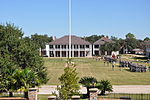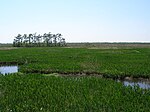Camp Hope
Camp Hope is a volunteer base camp located in a former school in St. Bernard Parish, Louisiana. Camp Hope has welcomed people from all over the United States and all over the world who have come to participate in the massive recovery efforts of St. Bernard Parish and New Orleans in the aftermath of Hurricane Katrina and Hurricane Rita and the Deepwater Horizon oil spill. Camp Hope provides affordable housing and meals for groups and individuals who have come to serve St Bernard parish and the city of New Orleans. Breakfast and dinner are served throughout the work week, as well as the option to make sack lunches to take on volunteer work sites. The facilities include a large dining area, bathrooms, showers, laundry facilities, meeting rooms, and bunk rooms with enough space to sleep over 300 individuals.
Excerpt from the Wikipedia article Camp Hope (License: CC BY-SA 3.0, Authors).Camp Hope
Aycock Street,
Geographical coordinates (GPS) Address Nearby Places Show on map
Geographical coordinates (GPS)
| Latitude | Longitude |
|---|---|
| N 29.965 ° | E -89.999 ° |
Address
Aycock Street 1961
70032
Louisiana, United States
Open on Google Maps









